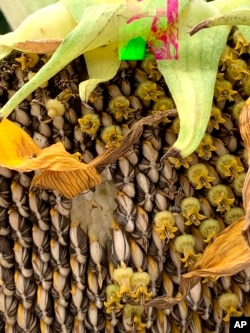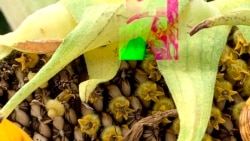Sunflowers are huge plants with bright yellow flowers. They have a long history in North America. There is evidence they were used for food and for medicine by Native Americans beginning around 1,000 B.C.
The seeds from sunflowers were likely brought to Europe by Spanish explorers around the late 16th century. Over time, they found their way to Eastern Europe.
Today, Ukraine is the world’s leading producer of the plants. Sunflowers are grown for their seeds and to make oil.
The plant has increasingly become popular on social media. That is because users enjoy taking pictures of themselves in bright fields of sunflowers. The photos are called “sunflower selfies.”
But in recent months, sunflower images are appearing on social media for a different reason: to show support for Ukraine following Russia’s invasion.
Gardening expert and writer Jessica Damiano recently wrote a story about growing sunflowers for The Associated Press. It is easy to grow your own sunflowers, she writes. Small versions of the plants can even be grown in containers.
How to grow
If you start growing sunflower from seeds, put them in room-temperature water for 2-8 hours before planting to start the growing process. Plant each seed into dirt 2.5 centimeters deep and 15 to 30 centimeters apart. Plant them after the danger of frost has passed or start indoors three weeks before your last frost date. Keep the soil wet, but not too wet, until the seeds begin to grow.
Sunflower plants can be moved outdoors when the danger of frost has passed in your area. Choose a place outside that will provide the plants with at least 6-8 hours of direct sunlight each day.
As the plants grow, they will develop long roots that work their way deep into the ground. So, before planting, it is important to loosen the soil. Dig at least one third of a meter down and remove any rocks.
Mix a large amount of compost into the soil where the plant will grow. Compost provides important, lasting nutrients that will help the plants all season long.
Water the plants when the soil dries. Aim to provide about 2.5 centimeters of water a week. Pay attention to the amount of rainfall your area receives each week. A five-centimeter layer of mulch will help the soil hold water and reduce competition from unwanted plants.
The sunflowers may not need additional nutrients if they were planted with compost. If compost was not added during the planting process, provide nutrients through a slow-release, all-purpose fertilizer one or two times during the growing season.
Some kinds of sunflowers can grow up to three meters tall. These kinds of sunflowers may require protection from strong winds. So, it is best to plant them against a structure that will protect them from the wind. You can also tie them to something tall for support.
When the flowers open, you can cut them and bring them inside. Put them in a container of water and enjoy their brightness and beauty.
How to eat
To gather the seeds, wait until the plants die back and the flowers start to fall at the end of the season. The backs of the flowers will be brown. The seeds will start coming out of the head. Cut the flowers off the plants. Then, put them into a bag or container to avoid spilling the seeds, which will be loose.
Remove the seeds by rubbing flowers with your hands or a hard brush. Do this over a container. Look through the seeds and remove parts of the plant that came off. Wash the seeds with water. Set them out to dry overnight.
Sunflower seeds may be eaten cooked or uncooked. To roast the seeds, you need an oven. Set the temperature to 165 degrees Celsius. Once the oven is heated, cook the seeds until they are brown. The process takes anywhere from 15 to 30 minutes. To make salted seeds, boil them in hot salted water for 90 minutes to two hours. Let them dry and then roast them in the oven.
I’m Jill Robbins.
Jessica Damiano reported this story for The Associated Press. Gregory Stachel adapted it for VOA Learning English.
____________________________________________________________________
Words in This Story
garden – n. an area of ground where plants (such as flowers or vegetables) are grown
frost – n. the occurrence of weather that is cold enough to cause water to freeze and frost to form
compost – n. a decayed mixture of plants (such as leaves and grass) that is used to improve the soil in a garden
mulch – n. a material (such as straw, leaves, or small pieces of wood) that is spread over the ground in a garden to protect the plants or help them grow and to stop weeds from growing
roast – v. to cook (food such as chicken, potatoes, or beef) with dry heat in an oven or over a fire
We want to hear from you. Write to us in the Comments section, and visit our Facebook page.













